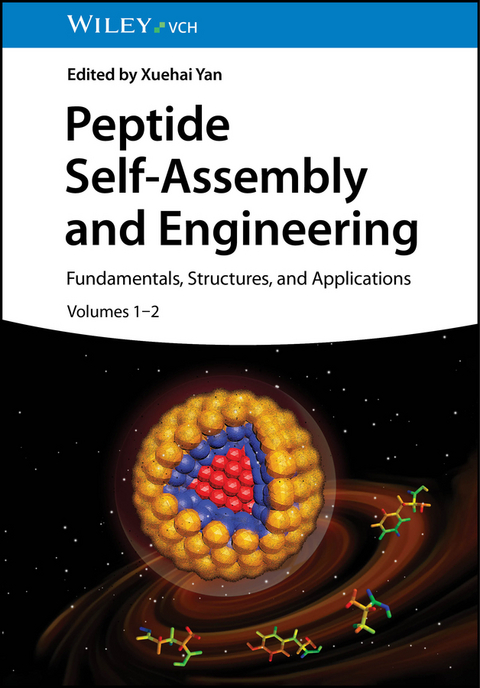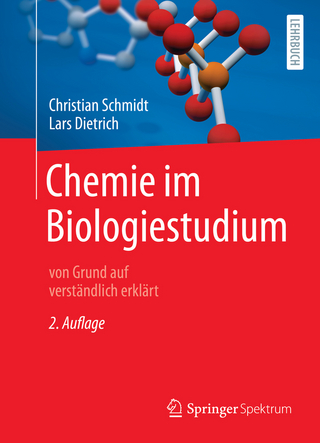
Peptide Self-Assembly and Engineering
Wiley-VCH (Verlag)
978-3-527-35191-6 (ISBN)
Xuehai Yan is currently Professor and Principle Investigator at the Institute of Process Engineering (IPE), the Chinese Academy of Sciences (CAS). He is the Vice Director at the State Key Laboratory of Biochemical Engineering and the Center of Mesoscience, IPE, CAS. He obtained his Ph.D. degree from the Institute of Chemistry, CAS in 2008 and then moved to the Max Planck Institute of Colloids and Interfaces in Germany for postdoctoral research as an Alexander von Humboldt fellow. He has been awarded National Natural Science Foundation of China (NSFC) Outstanding Young Scholar (2015) and NFSC Distinguished Young Scholar (2020). He was selected as Clarivate Analytics "Global Highly Cited Scientists" in 2020 and 2021. His research interests are focused on biomolecular self-assembly and engineering, supramolecular colloids and crystals, phase evolution and dynamic transition, as well as cancer phototherapy and immunotherapy.
VOLUME 1
Introduction
Peptides: molecular basis, secondary structures and synthesis methods
Principles of peptide self-assembly and material design rules
Molecular simulation and computational chemistry of peptide self-assembly
Stimuli-responsive structural transformations of peptide supramolecular gels
Self-assembling cyclic peptide nanotubes: methods and characterization
Design and control of self-sorting patterns of supramolecular peptide nanofibers
Protein-decorated artificial viral capsids self-assembled from ß-annulus peptides
Peptide assemblies on surfaces: a study using scanning tunneling microscopy
Molecular assembly of cyclic dipeptide: structure to function
Minimalistic peptide assemblies for sustainable optoelectronics
Peptide-based coacervates: a biomimetic protocell
Water-induced peptide self-assembly and its function
VOLUME 2
Functional peptide coatings
Self-assembling peptide amyloids: from structure to function in nanotechnology
Piezoelectric self-assembling peptides for engineering applications
Peptide-based hydrogels for soft electronic devices and wearable biosensors
Self-assembled peptide-based biocatalyst
Short peptide supramolecular hydrogels for antimicrobial applications
Supramolecular peptide-based nanomaterials for the treatment of fibrosis
Self-assembly of peptides and chromophores for design of theranostic nanodrugs and cancer precision therapy
Self-assembling bioactive peptides for supramolecular cancer immunotherapy
Self-assembled stimuli-responsive nanomaterials using peptide amphiphiles for targeting delivery of drugs
| Erscheinungsdatum | 18.02.2024 |
|---|---|
| Verlagsort | Berlin |
| Sprache | englisch |
| Maße | 170 x 244 mm |
| Gewicht | 1626 g |
| Themenwelt | Naturwissenschaften ► Biologie ► Biochemie |
| Naturwissenschaften ► Chemie ► Organische Chemie | |
| Technik ► Umwelttechnik / Biotechnologie | |
| Schlagworte | Biomolecules (DNA, RNA, Peptides, etc.) • Biomolekül • Biomoleküle • Biomoleküle (DNA, RNA, Peptide) • Chemie • Chemistry • Nanomaterialien • nanomaterials • Nanotechnologie • nanotechnology • Pharmaceutical & Medicinal Chemistry • Pharmazeutische u. Medizinische Chemie |
| ISBN-10 | 3-527-35191-4 / 3527351914 |
| ISBN-13 | 978-3-527-35191-6 / 9783527351916 |
| Zustand | Neuware |
| Informationen gemäß Produktsicherheitsverordnung (GPSR) | |
| Haben Sie eine Frage zum Produkt? |
aus dem Bereich


